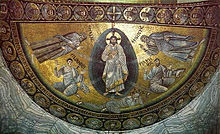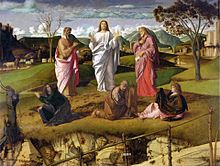Transfiguration of Jesus in Christian art
[4] The Gospel accounts (Matthew 17:1–9, Mark 9:2–8, Luke 9:28–36) describe the disciples as "sore afraid", but also as initially "heavy with sleep", and waking to see Jesus talking with Moses and Elijah and emitting a bright light.
The disciples are usually shown in a mixture of prostrate, kneeling, or reeling poses which are dramatic and ambitious by medieval standards and give the scene much of its impact.
Methods of depicting the bright light emitted by Jesus vary, including mandorlas, emanating rays, and giving him a gilded face, as in the Ingeborg Psalter.
[6] The Sinai image is recognizably the same scene as found on modern Orthodox icons, with some differences: only Christ has a halo, which is still typical at this date, and the plain gold background removes the question of depicting the mountain setting which was to cause later Western artists difficulties.
[7] A different, symbolic, approach is taken in the apse mosaic of the Basilica of Sant'Apollinare in Classe in Ravenna, also mid 6th century, where half-length figures of Moses (beardless) and Elijah emerge from little clouds on either side of a large jewelled cross with a Hand of God above it.
In Eastern depictions each prophet usually stands as secure as a mountain goat on his own little jagged peak; Christ may occupy another, or more often float in empty air between them.
[6] One solution was to have Christ and the prophets floating well above the ground, which is seen in some medieval depictions and was popular in the Renaissance and later, adopted by artists including Perugino and his pupil Raphael, whose Transfiguration in the Vatican Museums, his last painting, is undoubtedly the most important single Western painting of the subject, although very few other artists followed him in combining the scene with the next episode in Matthew, where a father brings his epileptic son to be healed.
The floating Christ inevitably recalled the composition of depictions of his Resurrection and Ascension, an association which Raphael and later artists were happy to exploit for effect.
The brilliant white of Christ's robes, the golden-yellow of his halo, and the bright blue of the sky behind him all serve to emphasize the ethereal nature of the event.
The so-called Dalmatic of Charlemagne in the Vatican, in fact a 14th or 15th century Byzantine embroidered vestment, is one of a number of depictions to include the subsidiary scenes of Christ and his disciples climbing and descending the mountain,[10] which also appear in the famous icon by Theophanes the Greek (above).
During the Feast of the Transfiguration the Orthodox sing a troparion which states that the disciples "beheld the Light as far as they were able to see it" signifying the varying levels of their spiritual progress.




